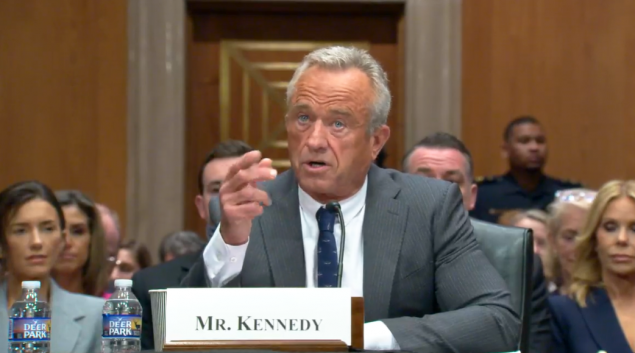
The Department of Health and Human Services announced a dramatic agency transformation on Thursday, that HHS Secretary Robert F. Kennedy, Jr., said will streamline operations by consolidating 28 divisions into 15 and reducing regional offices from 10 to five.
The workforce reductions and restructuring will “serve multiple goals without impacting critical services,” according HHS, with the transformation designed to “Make America Healthy Again” while saving about $1.8 billion annually.
WHY IT MATTERS
According to an HHS Fact Sheet, the U.S. Food and Drug Administration will see the most cuts from an estimated 10,000 layoffs department-wide.
-
FDA will decrease its workforce by about 3,500 full-time employees, “with a focus on streamlining operations and centralizing administrative functions,” according to HHS, which asserts that the reduction “will not affect drug, medical device or food reviewers, nor will it impact inspectors.”
-
The Centers for Disease Control and Prevention will lay off some 2,400 employees, “with a focus on returning to its core mission of preparing for and responding to epidemics and outbreaks.”
-
And the National Institutes of Health will decrease its workforce by approximately 1,200 FTEs, by “centralizing procurement, human resources, and communications across its 27 institutes and centers,” according to HHS.
-
CMS, meanwhile, will see its workforce reduced by approximately 300 employees, with a “focus on reducing minor duplication across the agency.” HHS says the reorganization “will not impact” the delivery of Medicare and Medicaid services.
“When combined with HHS’ other efforts, including early retirement and Fork in the Road, the restructuring results in a total downsizing from 82,000 to 62,000 full-time employees,” according to HHS.
As part of the changes at HHS, a new Administration for a Healthy America and will centralize core functions, including human resources, information technology, procurement and external affairs, HHS said in a statement.
The new AHA division includes the Office of the Assistant Secretary for Health, Health Resources and Services Administration, Substance Abuse and Mental Health Services Administration, Agency for Toxic Substances and Disease Registry and National Institute for Occupational Safety and Health.
The Administration for Strategic Preparedness and Response will be absorbed by the CDC, while HHS will merge the Assistant Secretary for Planning and Evaluation with the Agency for Healthcare Research and Quality and create the new Office of Strategy to direct federal health programs.
The nation’s top health agency also said that the restructuring promises to make the agency more responsive and efficient and ensure that Medicare, Medicaid and other essential health services remain intact.
Over time, agencies like HHS become “wasteful and inefficient,” even though “most of their staff are dedicated and competent civil servants,” said Kennedy in announcing the changes. “This Department will do more – a lot more – at a lower cost to the taxpayer.”
Critical programs, including the Administration for Children and Families, the aforementioned ASPE and the Centers for Medicare and Medicaid Services will be reorganized under an Administration for Community Living.
We’ve reached out to HHS to ask specifically about the any changes staffing or operations The Assistant Secretary for Technology Policy/Office of the National Coordinator for Health IT, and will update this story if there is a response.
THE LARGER TREND
This past month, HHS fired thousands of employees across the agency, which has traditionally been the country’s second largest behind the Department of Defense.
Officials at a National Institutes of Health department meeting had expected most of HHS’ approximately 5,200 probationary employees’ jobs to be terminated. Layoffs at the Centers for Medicare and Medicaid Services and the FDA also reported layoffs in the first few weeks of the Trump Administration.
HHS layoffs were temporarily reversed by a federal judge on March 13. The lawsuit, filed by a group of state attorneys general, reinstated all probationary employees in all federal departments, but many federal employees were put on administrative leave with pay in response.
In addition to taking early retirement, many federal employees, including those at HHS were offered a “Fork in the Road Program,” which promises pay and benefits in exchange for voluntarily departing their jobs if they defer resignation until September.
Overall, the new priority of a reorganized HHS under Secretary Kennedy is “ending America’s epidemic of chronic illness by focusing on safe, wholesome food, clean water and the elimination of environmental toxins,” the agency said.
However, that could be at odds with other Trump Administration priorities – like halting draft limits on per- and polyfluoroalkyl substances, known as PFAS, in a larger regulatory freeze – and Supreme Court changes to how a trimmer Environmental Protection Agency implements the Clean Water Act.
ON THE RECORD
“We aren’t just reducing bureaucratic sprawl,” said Kennedy said in a statement. “We are realigning the organization with its core mission and our new priorities in reversing the chronic disease epidemic.
“This overhaul will be a win-win for taxpayers and for those that HHS serves,” he added. “That’s the entire American public, because our goal is to Make America Healthy Again.”
Andrea Fox is senior editor of Healthcare IT News.
Email: afox@himss.org
Healthcare IT News is a HIMSS Media publication.
